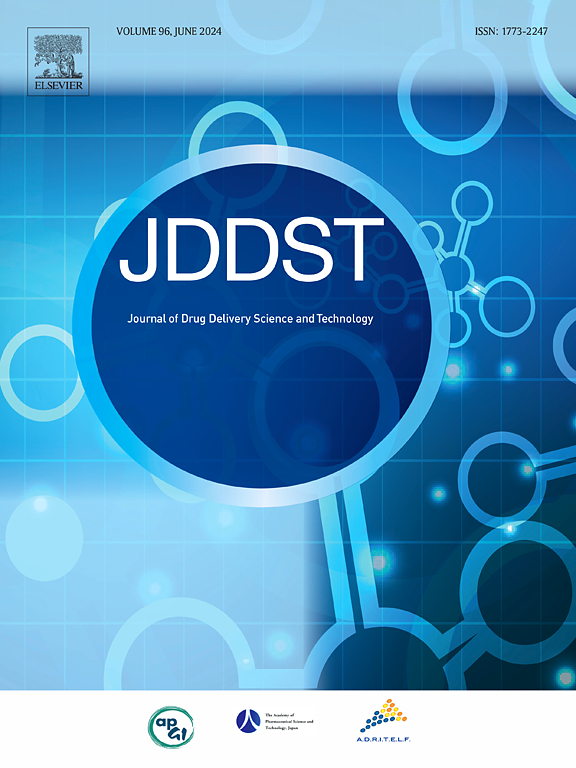ZIF-8 在纤维素微球上原位生长,具有高多柔比星负载能力和口服给药的 pH 敏感性
IF 4.5
3区 医学
Q1 PHARMACOLOGY & PHARMACY
Journal of Drug Delivery Science and Technology
Pub Date : 2024-10-11
DOI:10.1016/j.jddst.2024.106263
引用次数: 0
摘要
金属有机框架(MOF)纳米颗粒是一类具有广泛应用前景的多孔纳米材料。沸石咪唑盐酸盐框架(ZIF)材料具有高负载性能和pH敏感性等特点,在药物载体系统的开发中具有广阔的发展前景。本文以纤维素微球(CM)为载体,促进了ZIF-8纳米晶体的成核和生长。CM@ZIF-8采用原位制备,更加方便、灵活、经济、安全。作为一种新型载体,CM@ZIF-8 被用于监测抗癌药物多柔比星(DOX)的释放,并防止其在达到目标之前消散。傅立叶变换红外光谱(FTIR)、扫描电子显微镜(SEM)、N2吸附等温线、X射线衍射(XRD)和细胞毒性试验(细胞存活率为95.08%)对所设计的DOX负载CM@ZIF-8(CM@ZIF-8-DOX)系统进行了表征。在模拟体外肿瘤微环境中,CM@ZIF-8-DOX 表现出可控的药物释放行为(72 小时内药物释放率达 81.2%)。CM@ZIF-8同时具有很高的DOX负载能力(Qe = 159.71 mg∙g-1),在酸性条件(pH 5.0)下的释放量(15小时后为63.4%)大于中性条件(pH 7.4)下的释放量(15小时后为37.6%),这是由于金属离子与配体之间的配位脱离所致。本文章由计算机程序翻译,如有差异,请以英文原文为准。

In situ growth of ZIF-8 on cellulose microspheres with high doxorubicin loading capacity and pH-sensitive for oral drug delivery
Metal-organic framework (MOF) nanoparticles are a class of porous nanomaterials with wide application prospects. Zeolitic imidazolate framework (ZIF) materials have high loading performance and pH-sensitive characteristics, which means they have great development prospects in the development of drug carrier systems. Herein, cellulose microspheres (CM) were used as a carrier for the nucleation and growth of ZIF-8 nanocrystals. CM@ZIF-8 was prepared in situ, which was more convenient, flexible, cost-effective, and highly safe. CM@ZIF-8, as a novel carrier, was used to monitor the release of the anticancer drug Doxorubicin (DOX) and prevent it from dissipating before reaching its goal. The designed DOX-loaded CM@ZIF-8 (CM@ZIF-8-DOX) system was characterized by FTIR, SEM, N2 sorption isotherm, XRD, and Cytotoxicity assay (cells survival rate 95.08 %). CM@ZIF-8-DOX exhibited controlled drug release behavior in simulated in-vitro tumor microenvironments (81.2 % drug release throughout 72h). CM@ZIF-8 simultaneously had a high loading capacity of DOX (Qe = 159.71 mg∙g−1), and the amount released under acidic conditions (pH 5.0) was greater (63.4 % after 15 h) than under neutral conditions (pH 7.4) due to the detachment of the coordination between metal ions and ligands (37.6 % after 15 h).
求助全文
通过发布文献求助,成功后即可免费获取论文全文。
去求助
来源期刊
CiteScore
8.00
自引率
8.00%
发文量
879
审稿时长
94 days
期刊介绍:
The Journal of Drug Delivery Science and Technology is an international journal devoted to drug delivery and pharmaceutical technology. The journal covers all innovative aspects of all pharmaceutical dosage forms and the most advanced research on controlled release, bioavailability and drug absorption, nanomedicines, gene delivery, tissue engineering, etc. Hot topics, related to manufacturing processes and quality control, are also welcomed.

 求助内容:
求助内容: 应助结果提醒方式:
应助结果提醒方式:


